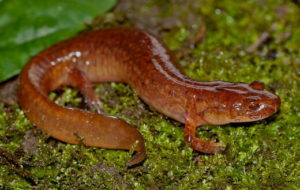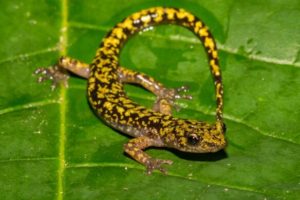Amphibians have unique skin compared to that of many other vertebrates. They use their skin to breathe, and also to ‘drink’ water.
Many salamanders feel slimy because their skin is covered in a mucous coating, which helps them keep their skin moist, enabling them to efficiently breathe through their skin. The slime also creates an environment for bacteria and microscopic fungi to live. These microbiomes help defend salamanders against disease, infection, and more.
That said, it’s important to note that not all species have moist, slimy skin. Some species species, especially newts, have grainy skin that is wet to the touch, rather than slimy.
Salamander Slime Helps Keep Their Skin Moist
As earlier mentioned, amphibians have unique skin compared to that of many other vertebrates. Their skin is composed of thin membranous tissue that is quite permeable to water and contains a large network of blood vessels.
This permeable skin distinguishes them from mammals, birds, or reptiles.
Permeability relates to how easily a gas or liquid molecule can pass back and forth from the environment into the animal and vice versa.
Typically, the larger the molecule, the more difficult it is to enter the animal through its skin. Amphibian skin is more permeable than that of other vertebrates.
Their membranous skin allows water and respiratory gases to readily diffuse directly down their gradients between the blood vessels and the surroundings.
To efficiently breathe through their skin, salamanders and other amphibians like frogs, have to keep their skin constantly moist by secreting a special mucous coating (which gives them a slimy feeling when touched).

The mucus that salamanders secrete traps moisture next to the skin. This moisture then transfers oxygen into the salamander’s bloodstream and allows carbon dioxide to diffuse out. This process is called cutaneous gas exchange.
Salamanders can only breathe through their skin if the skin stays moist. If it dries up, they can suffocate and die.
Salamander slime is also a conducive environment for bacteria and microscopic fungi to live. These microbiomes are extremely beneficial and can defend salamanders against disease, infection, and more.
How Is Salamander’s Slime Produced?
Amphibians tend to have more glands in their skin than other vertebrates. The most important glands are the granular and mucus glands.
In many poisonous salamanders, the poison is produced in the granular glands, and secreted over the skin as a defense against predators.
Mucus glands are much more numerous in amphibian skin than the granular glands and are responsible for producing the mucus coating.
Other Functions Of Salamander Skin
Apart from gas exchange, frog skin has other important functions:
1. Water Absorption
All animals need to consume water to survive. Dehydration can be harmful, and even potentially lethal to most salamanders. Their need for water is as critical as their need for food or oxygen–it’s an essential substance, that keeps their bodies working normally.
Salamanders generally do not drink water through their mouths as humans do, but instead, acquire water by absorption across their skin in a process known as ‘cutaneous absorption’.
Water absorption across this skin is driven by the osmotic gradient that develops as a consequence of solute transport.
In simple words, the skin acts in concert with the kidneys and urinary bladder to maintain fluid balance.
2. Camouflage
Salamanders have several ways to defend themselves from predators. Some salamanders such as the yellow spotted salamander produce skin secretions that are toxic or distasteful to many predators.
Animals that try to eat one of these salamanders, will get a mouthful of foul-tasting toxin, and spit the salamander out. If an animal eats a poisonous salamander or newt, it may get sick, or even die (depending on how toxic the salamander/newt species is).

Some salamanders do not have any toxic skin secretions and instead rely on the coloration of their skin camouflage or blend into the leaves and other debris in their environments, escaping the notice of most predators.
3. Protection Against The External Environment
Much like in humans, salamanders’ skin is the first line of defense against the external environment. It acts as the first physical barrier to withstand any pressure, stress, or trauma.
The epidermal and dermal layers of frog skin help protect them from the elements, although frogs are highly sensitive to contaminants in their environments.
Not All Salamanders Have Slimy Skin
Although most salamanders have smooth, moist skin with a slimy mucus coating not all do.
Many newts have dumpy skin with a leathery texture that is wet to the touch.

Despite the difference in skin texture, both newts and salamanders need damp conditions to keep their skin moist.
How Salamanders Keep Their Skins Moist
Salamanders and other amphibians prefer to live in cool, damp environments. They usually hang around shaded areas near ponds, swamps, streams, lakes, and other water bodies.
In hot, dry weather, they may seek out wet places like basements, or moist rotting logs to hide in.
During the summer, some salamanders may estivate.
To estivate, a salamander will retreat to a cool shaded area. Then, its heartbeat, breathing rate, and overall metabolic rate will dramatically decrease. This conserves energy and reduces the salamander’s need for food and water, during this period.
Some salamanders will also secrete mucus all over their skin. This mucus creates a protective cocoon and prevents the loss of moisture through the skin.
When the temperatures drop or the rain begins to fall, salamanders will emerge from estivation and be more active again.
Frequently Asked Questions
Why do salamanders have smooth slimy skin? Salamanders have smooth slimy skin because it is covered in a mucous coating which helps to keep it moist. Salamanders breathe through their skin, but they can only absorb oxygen through their skin if the skin stays moist. If it dries up, they can suffocate and die.
Are salamanders slimy? Salamanders are slimy to the touch because they have a mucous coating over their skin, which keeps their skin functioning.

